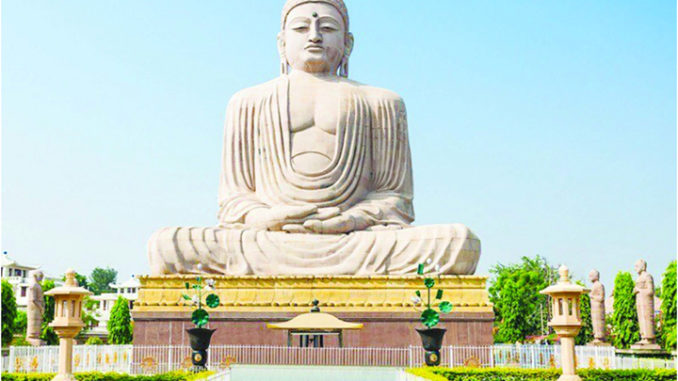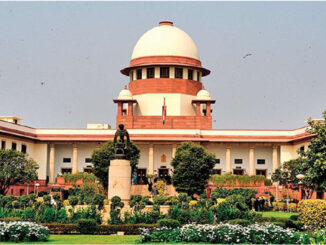
Bodh Gaya is a Buddhist pilgrimage site in Gaya District of Bihar. Famous for the Mahabodhi Temple, It was here under the Bodhi tree that Gautama Buddha attained enlightenment. It is now one of the UNESCO World Heritage Sites, and a lot of foreign countries, including Japan and China, have helped the Indian government in building facilities for the Buddhist pilgrims. The place is bustling with pilgrims all through the year from India and abroad who come to pay their homage in monasteries, temples and remnants of Bodhi Tree. Located near the river Neranjana, Bodh Gaya was earlier known as Uruwela. It was also known as Sambodhi, Vajrasana or Mahabodhi until the 18th century CE. It is one of the four important Buddhist sites that include: Kushinagar, Lumbini and Sarnath.
Places to visit – Mahabodhi Temple
The Mahabodhi temple, also called the “Great Awakening Temple”, is a UNESCO World Heritage Site located in Bodhgaya, Bihar. It is a Buddhist temple that marks the location where the Lord Buddha is said to have attained enlightenment. Lord Buddha holds a very significant place in the religious history of India as he is believed to be the 9th and the most recent incarnation of Lord Vishnu to have walked the earth. The temple spreads over an area of a whopping 4.8 hectares and is 55 meters tall. The Bodhi Tree is situated to the left of the temple and is believed to be the direct descendant of the actual tree under which Lord Gautam Buddha meditated and attained enlightenment and laid down his philosophy for life. The original temple was built by Emperor Ashoka after he turned to Buddhism in order to seek peace and solitude from war and conquests.
The great Emperor Ashoka visited Bodh Gaya in around 260 BC. During his visit, he constructed a small temple by a tree, which was the Bodhi tree- the tree under which Gautam Buddha was sitting when he attained enlightenment. An inscription dated back to between 1st century and 2nd century read that the temple built by Emperor Ashoka was replaced by a new one. Many monks and devotees can be seen performing countless prostrations to the tree. It’s a purificatory ritual, and some monks are known to do up to 1,00,000 prostrations at one time. The architecture of the temple and its overall silence and peace will surely enchant you as you visit it.
Great Buddha Statue
This statue of Lord Buddha is the tallest in India and was instated by the XIV Dalai Lama in 1989. It is a meditating Buddha resting on a giant lotus, constructed using intricately carved sandstone and red granite.
Bodhi Tree
The Bodhi Tree, located 100 kilometres to the south of Patna in the north Indian state of Bihar, is perhaps the most prominent and respected sacred places in Buddhism because of the rich historical significance attached to it. It is under this tree that Prince Siddhartha Gautama, the spiritual teacher who later became to be known as the Buddha, attained enlightenment. It is believed that Prince Siddhartha had to sit and meditate under this tree for seven days. Later on, a shrine known as Animisalocana Cetiya was erected on the spot where he had sat down. A small temple was also built near the Bodhi tree in the 7th century.
The Bodhi tree is a frequently visited destination spot by tourists and is one of the four main Buddhist pilgrimage sites. In fact, the Anandabodhi tree in Sravasti and the Bodhi tree in Anuradhapura, both of which are again significant places that find mention in the history of Buddhism, are believed to have been propagated from this tree here at Bodh Gaya. The aura of the Bodhi tree and the temple complex in which this tree is located have attracted sages, meditators and yogis to it ever since the time of the Buddha. Great and renowned spiritual figures like Buddhajnana, Padmasambhava, Vimalamitra, Nagarjuna and Atisha, have lived and meditated underneath the historically and religiously significant Bodhi Tree. Bodh Gaya is also popular for its UNESCO World Heritage Site- the Mahabodhi Temple Complex, which is just beside the tree. Religious people, as well as lovers of history, find this place especially fascinating.
Thai Monastery
Well known for its curved roof covered with exquisite tiles of gold, the Thai Monastery houses a bronze statue of Buddha and another recently erected 25m high statue in the garden.
Muchalinda Lake
A popular site at Bodh Gaya, the Muchalinda Lake is located next to the main temple. It is associated with a mythological tale stating that Lord Buddha was protected from the storm by Snake King Muchalinda.
A popular site at Bodh Gaya, the Muchalinda Lake is located next to the main temple. It is associated with a mythological tale stating that Lord Buddha was protected from the storm by Snake King Muchalinda.
Vishnupad Temple
As the name suggests, this temple was built as a dedication to Lord Vishnu and features a 40 cm long footprint of Lord Vishnu that is enclosed by a basin made of silver plates.
This footprint marks the act of Lord Vishnu subduing Gayasur by placing his feet on Gayasur’s chest. Within the courtyard, there are other temples situated as well. One is dedicated to Lord Narasimha and another to Lord Shiva in the form of Phalgwisvara. This temple serves as a very significant place of worship for Hindus and is located in Gaya.
Dungeshwari Hills
Dungeshwari Hills is where Lord Buddha spent a few years before travelling to Bodh Gaya in search of enlightenment. The hills are mostly known for the caves that Gautam Buddha used for shelter and meditation. The Stupas/ Buddhist shrines exist even today amidst the beautiful natural surroundings. The picturesque location of the Dungeshwari Hills is also a well-known trekking destination and draws enthusiasts in large numbers.





Be the first to comment